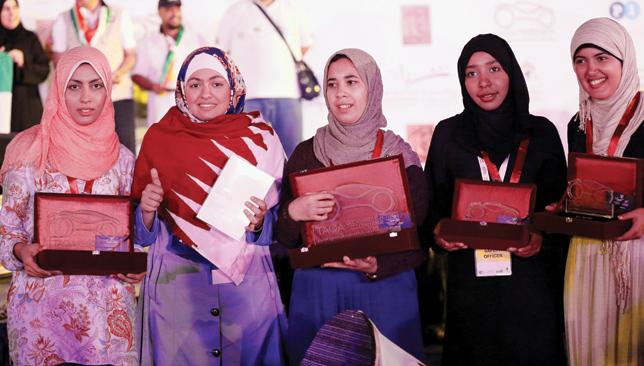
Qatar University girls’ team (Gernas 114) held their nerve to win the inaugural 2014 Taqa GCC Hybrid-Electric Challenge in Abu Dhabi.
The girls beat their male counterparts (Gernas 214) from the same university with just 22.32 seconds separating the winners from the second placed team in the Hybrid-Electric Grand Prix (HE-GP) race category.
The girls were crowned champions after accumulating the fastest time overall following a third-place finish in the Electric Grand Prix (EGP) in the two-stage challenge.
MCT-Oman of Nizwa College of Technology finished third in the region’s first hybrid-electric car challenge. Sherouk Mohamed said the victory was unexpected.
“It’s amazing to win. It’s a great feeling,” said the delighted Qatari. “We didn’t expect it all (the win). We would’ve been happy to reach third or fourth place but we beat the boys’ team as well, which is so good.
“It’s kind of amazing because they kept telling me we will not beat them. On the track they kept following us but we did well and finished very smoothly in the race.”
Sherouk had alongside her two other drivers, Rehab Ahmed and Nour Al Houda.
Qatar University team leader Chresteen Fareed said: “We are so proud to be champions of the first ever Taqa GCC Hybrid-Electric Challenge.
“Taking part in this event has been a great experience and has given us the chance to take what we have learnt in the classroom and apply it to a real life situation.”
More than 120 students from the Petroleum Institute in Abu Dhabi, Abu Dhabi University, UAE University, Khalifa University, the Masdar Institute, the Nizwa College of Technology in Oman, the College of Technological Studies in Kuwait and Qatar took part in the two-day challenge.
Each team designed and constructed their single-seater, lightweight hybrid cars in compliance with the race design and safety rules.
These cars were later driven around Al Forsan sports resort. In the E-GP, students drove their cars as fast as possible for 60 minutes, using only the energy stored in their batteries.
During the second stage, the teams were permitted a combination of petrol and electric power to travel the maximum distance on the least amount of energy over 180 minutes in the HE-GP.